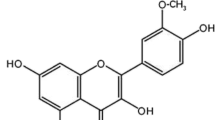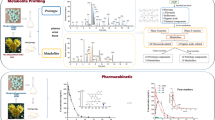Abstract
Background and Objectives
Naringin, an active flavanone glycoside, has been widely considered as a prospective antitussive and expectorant. The present study aimed to elucidate the metabolic profile of naringin in the human body.
Methods
Four male and three female volunteers (20–30 years old and 18.8–21.7 kg/m2 Body Mass Index) were orally administrated 320 mg naringin; their urine and feces were collected at different times and the corresponding metabolites were identified with a high resolution ultra-fast liquid chromatography-quadrupole-time-of-flight tandem mass spectrometry (UFLC-Q-TOF–MS/MS) system.
Results
Sixteen conjugative metabolites and five polyphenols were identified. These detected metabolites varied in the types, relative responses, and excretion times among different individuals.
Conclusions
The results revealed that naringin underwent extensive phase II metabolism in the human body and yielded an array of conjugated products. This study provided a reference for further clinical studies and in vivo metabolism of other flavonoids.
Graphical Abstract







Similar content being viewed by others
References
Ahmad SF, Attia SM, Bakheet SA, Zoheir KMA, Ansari MA, Korashy HM, et al. Naringin attenuates the development of carrageenan-induced acute lung inflammation through inhibition of NF-kappa b, STAT3 and pro-inflammatory mediators and enhancement of I kappa B alpha and anti-inflammatory cytokines. Inflammation. 2015;38(2):846–57.
Bacanli M, Basaran AA, Basaran N. The antioxidant and antigenotoxic properties of citrus phenolics limonene and naringin. Food Chem Toxicol. 2015;81:160–70.
Xulu S, Owira PMO. Naringin ameliorates atherogenic dyslipidemia but not hyperglycemia in rats with type 1 diabetes. J Cardiovasc Pharmacol. 2012;59(2):133–41.
Gopinath K, Sudhandiran G. Protective effect of naringin on 3-nitropropionic acid-induced neurodegeneration through the modulation of matrix metalloproteinases and glial fibrillary acidic protein. Can J Physiol Pharmacol. 2015;94(1):1–7.
Gao S, Li P, Yang H, Fang S, Su W. Antitussive effect of naringin on experimentally induced cough in Guinea pigs. Planta Med. 2011;77(1):16–21.
Liu Y, Wu H, Nie YC, Chen JL, Su WW, Li PB. Naringin attenuates acute lung injury in LPS-treated mice by inhibiting NF-kappa B pathway. Int Immunopharmacol. 2011;11(10):1606–12.
Orrego-Lagaron N, Martinez-Huelamo M, Vallverdu-Queralt A, Lamuela-Raventos RM, Escribano-Ferrer E. High gastrointestinal permeability and local metabolism of naringenin: influence of antibiotic treatment on absorption and metabolism. Br J Nutr. 2015;114(2):169–80.
Lin SP, Hou YC, Tsai SY, Wang MJ, Lee Chao PD. Tissue distribution of naringenin conjugated metabolites following repeated dosing of naringin to rats. BioMedicine (Netherlands). 2014;4(3):1–6.
Zou W, Yang C, Liu M, Su W. Tissue distribution study of naringin in rats by liquid chromatography–tandem mass spectrometry. Arzneimittelforschung. 2012;62(4):181–6.
Fang TZ, Wang YG, Ma Y, Su WW, Bai Y, Zhao PY. A rapid LC/MS/MS quantitation assay for naringin and its two metabolites in rats plasma. J Pharm Biomed Anal. 2006;40(2):454–9.
Liu MH, Zou W, Yang CP, Peng W, Su WW. Metabolism and excretion studies of oral administered naringin, a putative antitussive, in rats and dogs. Biopharm Drug Dispos. 2012;33(3):123–34.
Hsiu SL, Huang TY, Hou YC, Chin DH, Chao PDL. Comparison of metabolic pharmacokinetics of naringin and naringenin in rabbits. Life Sci. 2002;70(13):1481–9.
Mata-Bilbao MD, Andres-Lacueva C, Roura E, Jaduregui O, Escriban E, Torre C, et al. Absorption and pharmacokinetics of grapefruit flavanones in beagles. Br J Nutr. 2007;98(1):86–92.
Ishii K, Furuta T, Kasuya Y. Mass spectrometric identification and high-performance liquid chromatographic determination of a flavonoid glycoside naringin in human urine. J Agric Food Chem. 2000;48(1):56–9.
Kanaze FI, Bounartzi MI, Georgarakis M, Niopas I. Pharmacokinetics of the citrus flavanone aglycones hesperetin and naringenin after single oral administration in human subjects. Eur J Clin Nutr. 2007;61(4):472–7.
Bredsdorff L, Nielsen ILF, Rasmussen SE, Cornett C, Barron D, Bouisset F, et al. Absorption, conjugation and excretion of the flavanones, naringenin and hesperetin from alpha-rhamnosidase-treated orange juice in human subjects. Br J Nutr. 2010;103(11):1602–9.
Zhang JM, Brodbelt JS. Screening flavonoid metabolites of naringin and narirutin in urine after human consumption of grapefruit juice by LC–MS and LC–MS/MS. Analyst. 2004;129(12):1227–33.
Pereira-Caro G, Borges G, van der Hooft JD, Clifford MN, Del Rio D, Lean MEJ, et al. Orange juice (poly)phenols are highly bioavailable in humans. Am J Clin Nutr. 2014;100(5):1378–84.
Vallejo F, Larrosa M, Escudero E, Zafrilla MP, Cerda B, Boza J, et al. Concentration and solubility of flavanones in orange beverages affect their bioavailability in humans. J Agric Food Chem. 2010;58(10):6516–24.
Mullen W, Archeveque MA, Edwards CA, Matsumoto H, Crozier A. Bioavailability and metabolism of orange juice flavanones in humans: impact of a full-fat yogurt. J Agric Food Chem. 2008;56(23):11157–64.
Rechner AR, Smith MA, Kuhnle G, Gibson GR, Debnam ES, Srai SKS, et al. Colonic metabolism of dietary polyphenols: influence of structure on microbial fermentation products. Free Radic Biol Med. 2004;36(2):212–25.
Zou W, Luo YL, Liu MH, Chen S, Wang S, Nie YC, et al. Human intestinal microbial metabolism of naringin. Eur J Drug Metab Pharmacokinet. 2015;40(3):363–7.
Ma YL, Li QM, Van den Heuvel H, Claeys M. Characterization of flavone and flavonol aglycones by collision-induced dissociation tandem mass spectrometry. Rapid Commun Mass Spectrom. 1997;11(12):1357–64.
Fabre N, Rustan I, Hoffmann ED, Quetin-Leclercq J. Determination of flavone, flavonol, and flavanone aglycones by negative ion liquid chromatography electrospray ion trap mass spectrometry. J Am Soc Mass Spectrom. 2001;12(6):707–15.
Wang MJ, Chao PDL, Hou YC, Hsiu SL, Wen KC, Tsai SY. Pharmacokinetics and conjugation metabolism of naringin and naringenin in rats after single dose and multiple dose administrations. J Food Drug Anal. 2006;14(3):247–53.
Ruan FY, Chen RD, Li JH, Zhang M, Xie KB, Wang Y, et al. Sulfation of naringenin by Mucor sp. Zhongguo Zhongyao Zazhi. 2014;39(11):2039–42.
Chen Z, Zheng S, Li L, Jiang H. Metabolism of flavonoids in human: a comprehensive review. Curr Drug Metab. 2014;15(1):48–61.
Yanez JA, Remsberg CM, Miranda ND, Vega-Villa KR, Andrews PK, Davies NM. Pharmacokinetics of selected chiral flavonoids: hesperetin, naringenin and eriodictyol in rats and their content in fruit juices. Biopharm Drug Dispos. 2008;29(2):63–82.
Labib S, Erb A, Kraus M, Wickert T, Richling E. The pig caecum model: a suitable tool to study the intestinal metabolism of flavonoids. Mol Nutr Food Res. 2004;48(4):326–32.
Jenner AM, Rafter J, Halliwell B. Human fecal water content of phenolics: the extent of colonic exposure to aromatic compounds. Free Radic Biol Med. 2005;38(6):763–72.
Schoefer L, Mohan R, Schwiertz A, Braune A, Blaut M. Anaerobic degradation of flavonoids by Clostridium orbiscindens. Appl Environ Microbiol. 2003;69(10):5849–54.
Simons AL, Renouf M, Hendrich S, Murphy PA. Human gut microbial degradation of flavonoids: structure-function relationships. J Agric Food Chem. 2005;53(10):4258–63.
Serra A, Macia A, Romero MP, Reguant J, Ortega N, Motilva MJ. Metabolic pathways of the colonic metabolism of flavonoids (flavonols, flavones and flavanones) and phenolic acids. Food Chem. 2012;130(2):383–93.
Acknowledgments
This work was financial supported by the fund of National Major Scientific and Technical Special Project of China (No. 2015ZX09101014), National Natural Science Foundation of China (No. 81374041), and Applied Science and Technology R&D Special Fund Project of Guangdong Province (No. 2015B020234004).
Author information
Authors and Affiliations
Corresponding author
Ethics declarations
Conflict of interest
All the authors declare that there are no known conflicts of interest with this publication.
Ethical approval
All procedures performed in studies involving human participants were in accordance with the ethical standards of the institutional and/or national research committee and with the 1964 Helsinki declaration and its later amendments or comparable ethical standards. This study was conducted with the authorization of the Ethics Committee of the School of Life Science, Sun Yat-sen University, Guangzhou 510275, P.R. China.
Informed consent
Informed consent was obtained from all individual participants included in the study.
Electronic supplementary material
Below is the link to the electronic supplementary material.
Rights and permissions
About this article
Cite this article
Zeng, X., Bai, Y., Peng, W. et al. Identification of Naringin Metabolites in Human Urine and Feces. Eur J Drug Metab Pharmacokinet 42, 647–656 (2017). https://doi.org/10.1007/s13318-016-0380-z
Published:
Issue Date:
DOI: https://doi.org/10.1007/s13318-016-0380-z




